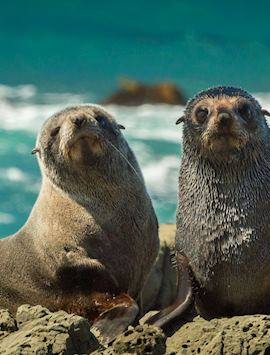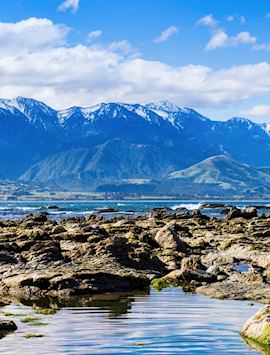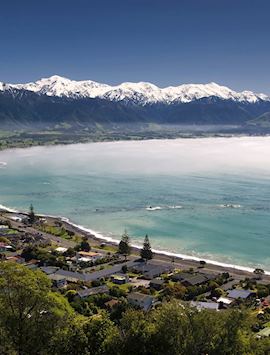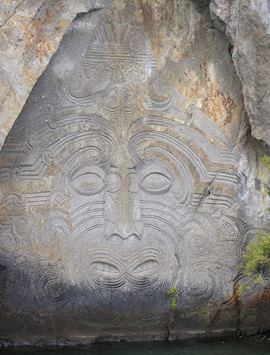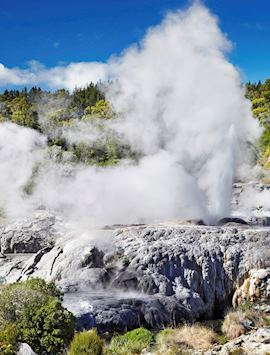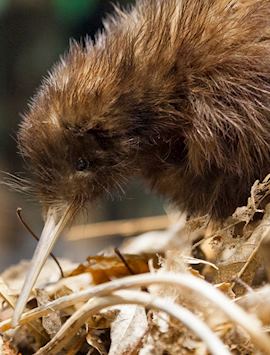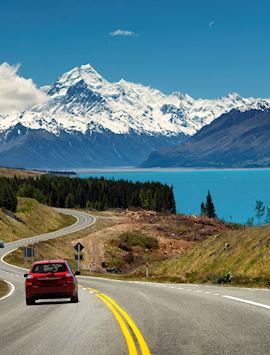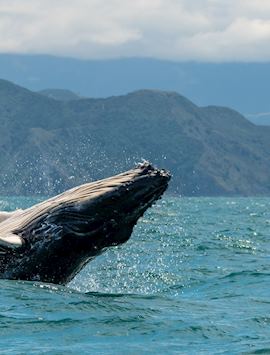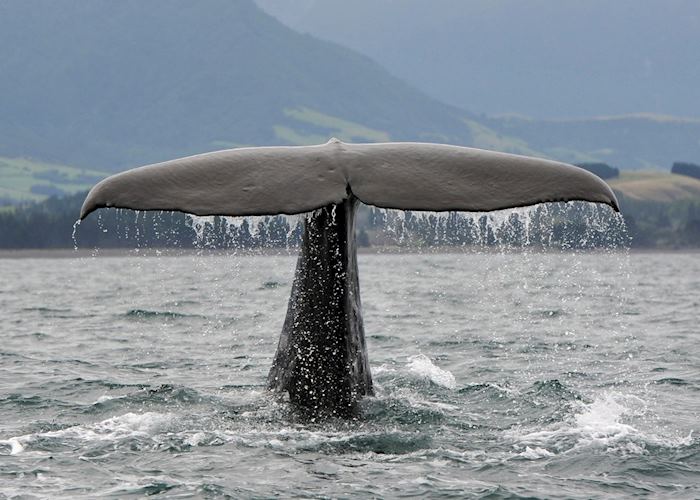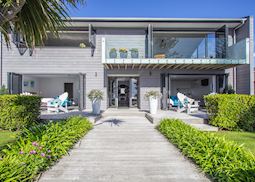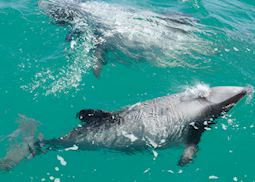Jump to:
Kaikoura is an idyllic small seaside township on a rocky peninsula, with a superb beach and also a walkway encased with pairs of whale ribs, known as the ‘Garden of Memories’.
What makes it unique are the very deep waters that mix warm and cold ocean currents, forcing nutrients to the surface and attracting pods of up to 300 dolphins, sperm whales, fur seals and many marine species.
Wildlife spotting
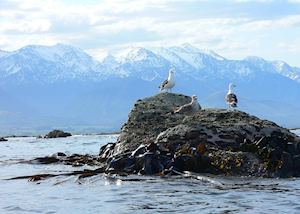 These great sea mammals are best seen on whale watching excursions, often the highlight of your trip to New Zealand, usually by boat but with a further option being to spot them from the air, on a ‘Wings over Whales’ light aircraft flight.
These great sea mammals are best seen on whale watching excursions, often the highlight of your trip to New Zealand, usually by boat but with a further option being to spot them from the air, on a ‘Wings over Whales’ light aircraft flight.
The ocean is also alive with seabirds including the black-browed mollymawk, Antarctic fulmar and the royal albatross.
Kaikoura's heritage and culture
On land, the region is also of significant historical note, as the area’s abundant food sources attracted Māori settlement and local Māori guides can bring the indigenous history to life.
The name Kaikoura comes from the Māori words for ‘eat’ and ‘crayfish’, and whilst in town you should definitely make sure to try this local delicacy. You can choose either to order it from one of the excellent local restaurants, or alternatively to drive just north of town to the tiny crayfish vans, where you can purchase your cray and eat it fresh by the waves of the Pacific Ocean.
Whale watching
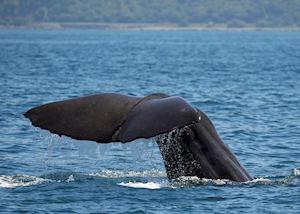 Most visitors are drawn to Kaikoura for its abundant marine life, and there are excellent opportunities to experience this both by air and by sea.
Most visitors are drawn to Kaikoura for its abundant marine life, and there are excellent opportunities to experience this both by air and by sea.
Specially designed modern catamarans with sophisticated on-board technology provide an exciting and informative three-hour trip, getting you close to the New Zealand fur seal, dusky dolphins and the giant sperm whale.
Alternatively, a scenic flight gives you an aerial perspective as well as incredible views of the surrounding landscape.
who's been there
-
617-223-4521617-223-4580
- Make an inquiry
Suggested itineraries featuring Kaikoura
Our itineraries will give you suggestions for what is possible when you travel in Kaikoura, and they showcase routes we know work particularly well. Treat them as inspiration, because your trip will be created uniquely by one of our specialists.
Places near Kaikoura
- Hanmer Springs 45 miles away
- Blenheim 63 miles away
- Picton 79 miles away
- Nelson 81 miles away
- Marlborough Sounds 90 miles away
- Christchurch 95 miles away
- Wellington 96 miles away
- Akaroa & Banks Peninsula 104 miles away
- Kahurangi National Park 106 miles away
- Abel Tasman National Park 109 miles away
- Arthur's Pass National Park 114 miles away
- Punakaiki 122 miles away
- Martinborough 124 miles away
- The Kapiti Coast 126 miles away
- Wairarapa & surrounds 129 miles away
- Greytown 130 miles away
- Collingwood & Farewell Spit 130 miles away
- Hokitika 140 miles away
- Whanganui National Park 186 miles away
- Lake Tekapo 196 miles away
- Fox & Franz Josef Glaciers 200 miles away
- Mount Cook National Park 203 miles away
- South Island 206 miles away
- Twizel 222 miles away
- Taranaki & New Plymouth 233 miles away
- Tongariro National Park 240 miles away
- Hastings 253 miles away
- Hawke's Bay 261 miles away
- Napier 263 miles away
- North Island 275 miles away
- Lake Wanaka 278 miles away
- The Otago Peninsula 283 miles away
- Lake Taupo 286 miles away
- Dunedin 288 miles away
- Waitomo 296 miles away
- Arrowtown 300 miles away
Photos of Kaikoura
Accommodation choices for Kaikoura
We've selected a range of accommodation options for when you visit Kaikoura. Our choices usually come recommended for their character, facilities and service or location. Our specialists always aim to suggest properties that match your preferences.
-
![The Hamptons]()
The Hamptons
Kaikoura -
![Sudima Kaikoura]()
Sudima Kaikoura
Kaikoura -
![Hapuku Lodge]()
Hapuku Lodge
Kaikoura -
![Kahutara PurePod]()
Kahutara PurePod
Kaikoura
Ideas for experiencing Kaikoura
Our specialists seek out authentic ways to get to know the places that could feature in your trip. These activities reflect some of the experiences they've most enjoyed while visiting Kaikoura, and which use the best local guides.
-
Dolphin swim ![A pair of Hector's dolphins]()
Dolphin swim
Dolphin swim
This three-hour excursion is perhaps the best way in the world to swim with dolphins. Kaikoura attracts dolphins all year round, hugely increasing the chances of being able to get in the water with these incredible creatures.
View details -
Swimming with seals in Kaikoura ![New Zealand fur seals, Kaikoura]()
Swimming with seals in Kaikoura
Swimming with seals in Kaikoura
One of the best nature activities in New Zealand, swimming with wild New Zealand fur seals in Kaikoura is a truly unique experience.
View details -
Whale watching in Kaikoura ![Sperm whale, Kaikoura]()
Whale watching in Kaikoura
Whale watching in Kaikoura
Spot whales surfacing in Kaikoura, New Zealand. You’ll head out to sea for three hours with a responsible local tour operator and guide, where you have exceptionally high chances of viewing sperm whales, dusky dolphins, fur seals, and royal albatrosses.
View details


